Abstract
Survival of Clostridium difficile in an aerobic environment is possible because of spore formation. When sodium taurocholate is substituted for the egg yolk of a selective medium, cycloserine-cefoxitin-fructose-agar (CCFA), enhanced recovery of C. difficile spores is shown. This selective medium (TCCFA) does not improve recovery of vegetative forms. In this study, dry and saline-moistened swabs, adhesive paddles, and Rodac plates containing CCFA and TCCFA were compared in their ability to recover C. difficile spores from an inoculated surface. Rodac plates grew 20 to 25 times as many spores on TCCFA as on CCFA. Saline-moistened swabs recovered fewer organisms than Rodac plates. Dry swabs and adhesive paddles rarely recovered spores. Prereduction of agar in an anaerobic chamber was not necessary for optimal spore recovery. Optimal growth of vegetative C. difficile required prereduced media. Agar prereduced for 2 h supported the growth of 12 C. difficile isolates as well as agar prereduced for 18 h. Vegetative cells of C. difficile survived for only 15 min in room air. Use of Rodac plates containing TCCFA is preferred for detection of C. difficile spores in the hospital environment.
Full text
PDF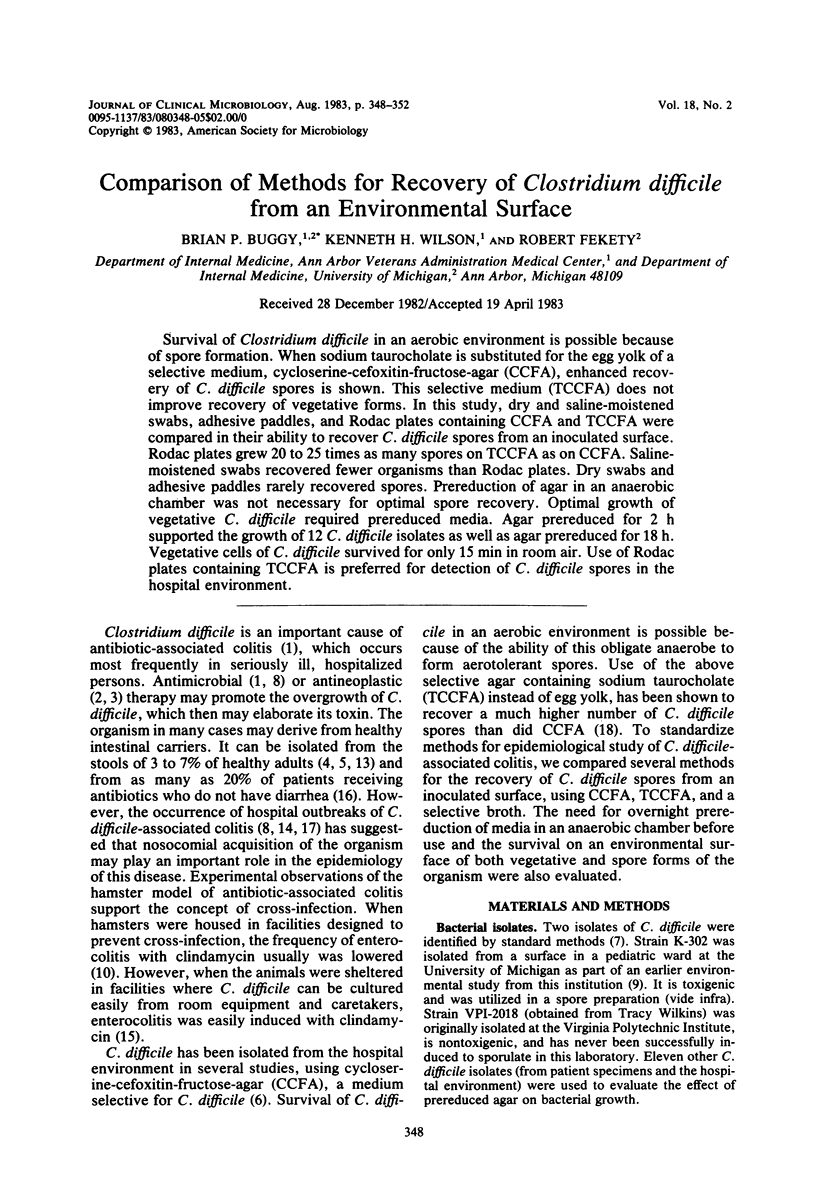
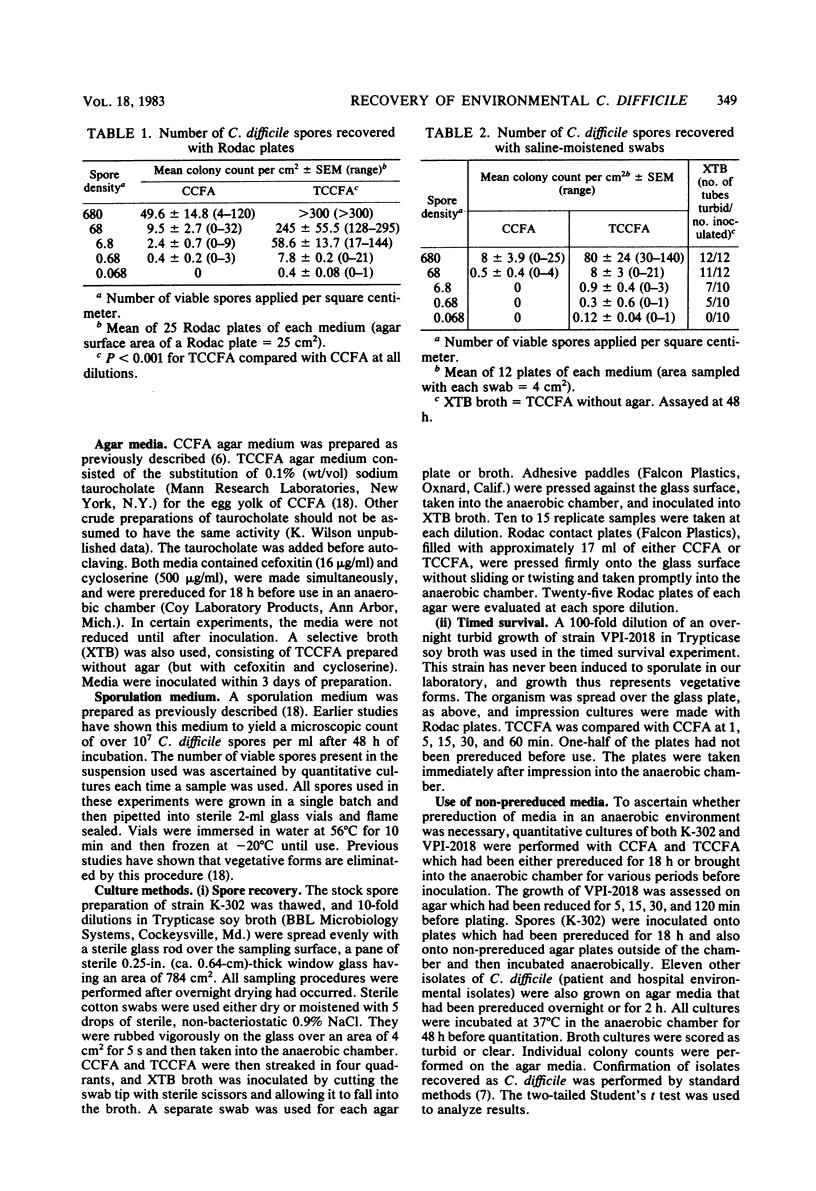
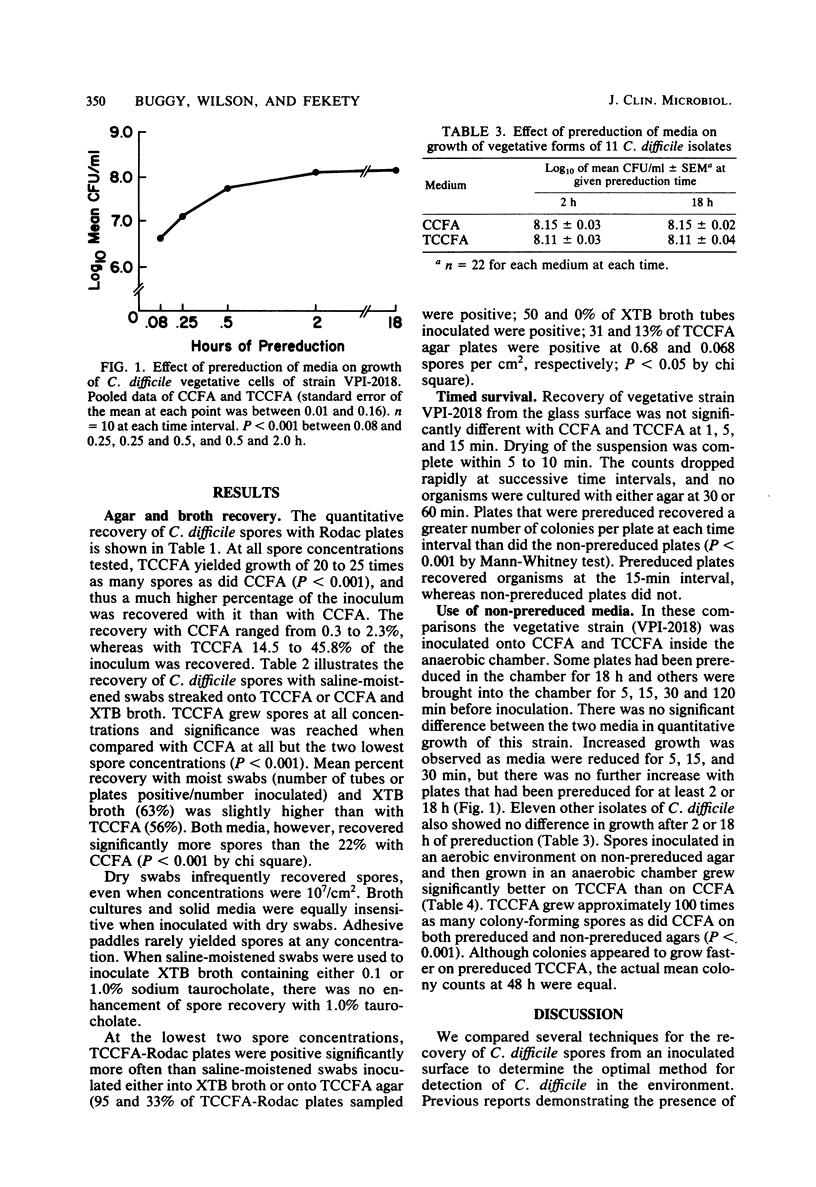
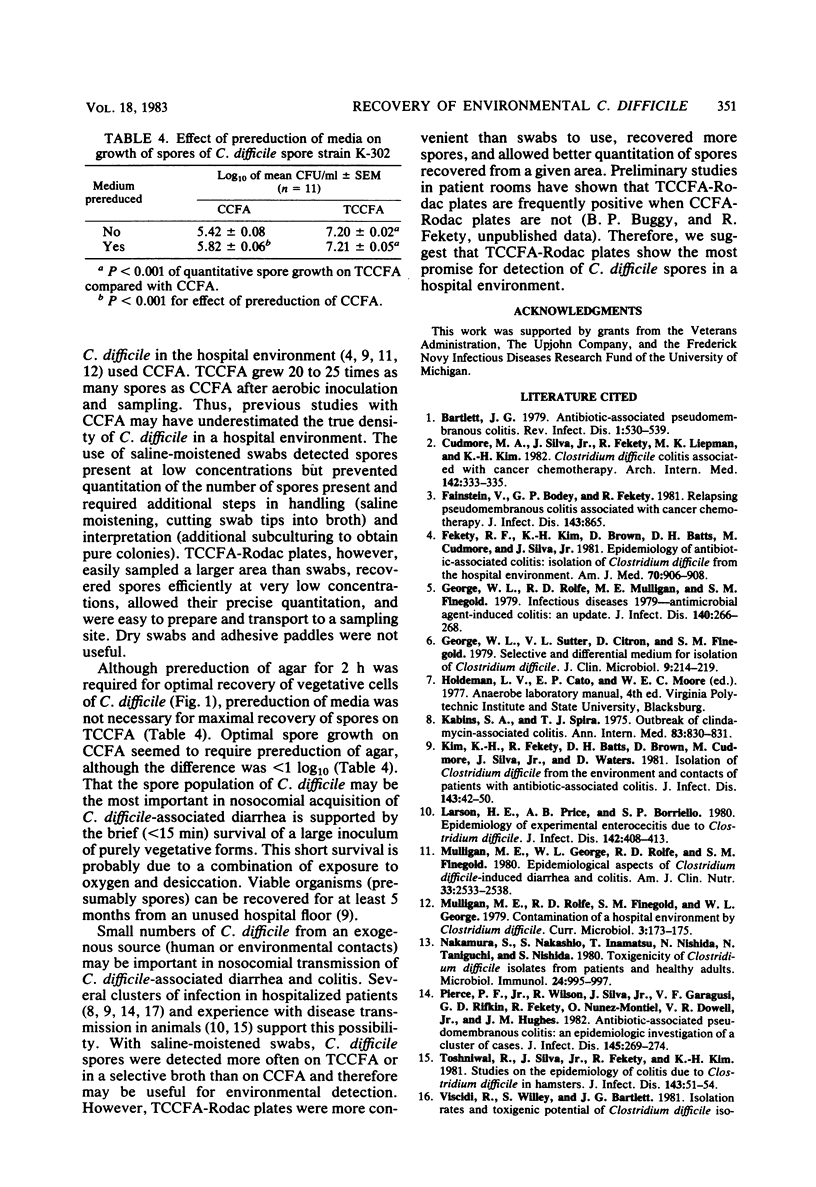
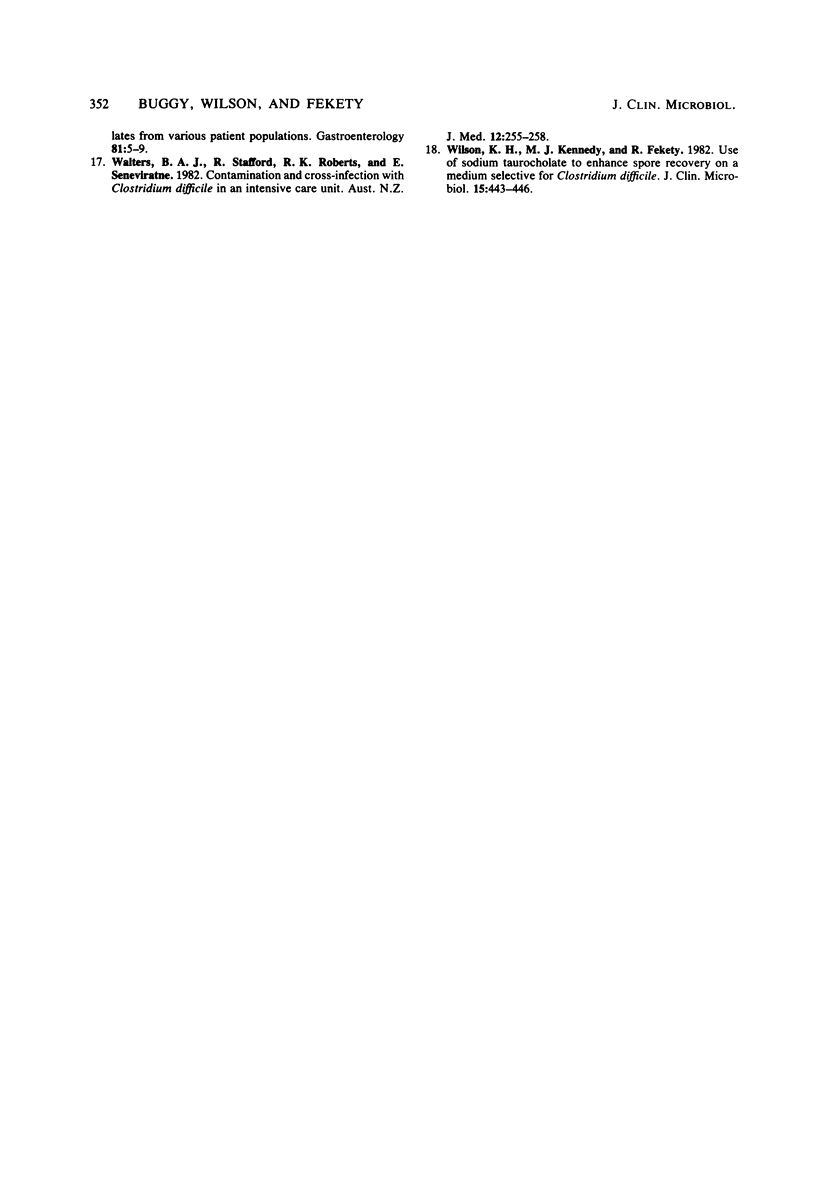
Selected References
These references are in PubMed. This may not be the complete list of references from this article.
- Bartlett J. G. Antibiotic-associated pseudomembranous colitis. Rev Infect Dis. 1979 May-Jun;1(3):530–539. doi: 10.1093/clinids/1.3.530. [DOI] [PubMed] [Google Scholar]
- Cudmore M. A., Silva J., Jr, Fekety R., Liepman M. K., Kim K. H. Clostridium difficile colitis associated with cancer chemotherapy. Arch Intern Med. 1982 Feb;142(2):333–335. [PubMed] [Google Scholar]
- Fainstein V., Bodey G. P., Fekety R. Relapsing pseudomembranous colitis associated with cancer chemotherapy. J Infect Dis. 1981 Jun;143(6):865–865. doi: 10.1093/infdis/143.6.865. [DOI] [PubMed] [Google Scholar]
- Fekety R., Kim K. H., Brown D., Batts D. H., Cudmore M., Silva J., Jr Epidemiology of antibiotic-associated colitis; isolation of Clostridium difficile from the hospital environment. Am J Med. 1981 Apr;70(4):906–908. doi: 10.1016/0002-9343(81)90553-2. [DOI] [PubMed] [Google Scholar]
- George W. L., Rolfe R. D., Mulligan M. E., Finegold S. M. Infectious diseases 1979--antimicrobial agent-induced colitis: an update. J Infect Dis. 1979 Aug;140(2):266–268. doi: 10.1093/infdis/140.2.266. [DOI] [PubMed] [Google Scholar]
- George W. L., Sutter V. L., Citron D., Finegold S. M. Selective and differential medium for isolation of Clostridium difficile. J Clin Microbiol. 1979 Feb;9(2):214–219. doi: 10.1128/jcm.9.2.214-219.1979. [DOI] [PMC free article] [PubMed] [Google Scholar]
- Kabins S. A., Spira T. J. Outbreak of clindamycin-associated colitis. Ann Intern Med. 1975 Dec;83(6):830–831. doi: 10.7326/0003-4819-83-6-830. [DOI] [PubMed] [Google Scholar]
- Kim K. H., Fekety R., Batts D. H., Brown D., Cudmore M., Silva J., Jr, Waters D. Isolation of Clostridium difficile from the environment and contacts of patients with antibiotic-associated colitis. J Infect Dis. 1981 Jan;143(1):42–50. doi: 10.1093/infdis/143.1.42. [DOI] [PubMed] [Google Scholar]
- Larson H. E., Price A. B., Borriello S. P. Epidemiology of experimental enterocecitis due to Clostridium difficile. J Infect Dis. 1980 Sep;142(3):408–413. doi: 10.1093/infdis/142.3.408. [DOI] [PubMed] [Google Scholar]
- Mulligan M. E., George W. L., Rolfe R. D., Finegold S. M. Epidemiological aspects of Clostridium difficile-induced diarrhea and colitis. Am J Clin Nutr. 1980 Nov;33(11 Suppl):2533–2538. doi: 10.1093/ajcn/33.11.2533. [DOI] [PubMed] [Google Scholar]
- Nakamura S., Nakashio S., Inamatsu T., Nishida N., Taniguchi N., Nishida S. Toxigenicity of Clostridium difficile isolates from patients and healthy adults. Microbiol Immunol. 1980;24(10):995–997. doi: 10.1111/j.1348-0421.1980.tb02904.x. [DOI] [PubMed] [Google Scholar]
- Pierce P. F., Jr, Wilson R., Silva J., Jr, Garagusi V. F., Rifkin G. D., Fekety R., Nunez-Montiel O., Dowell V. R., Jr, Hughes J. M. Antibiotic-associated pseudomembranous colitis: an epidemiologic investigation of a cluster of cases. J Infect Dis. 1982 Feb;145(2):269–274. doi: 10.1093/infdis/145.2.269. [DOI] [PubMed] [Google Scholar]
- Toshniwal R., Silva J., Jr, Fekety R., Kim K. H. Studies on the epidemiology of colitis due to Clostridium difficile in hamsters. J Infect Dis. 1981 Jan;143(1):51–54. doi: 10.1093/infdis/143.1.51. [DOI] [PubMed] [Google Scholar]
- Walters B. A., Stafford R., Roberts R. K., Seneviratne E. Contamination and crossinfection with Clostridium difficile in an intensive care unit. Aust N Z J Med. 1982 Jun;12(3):255–258. doi: 10.1111/j.1445-5994.1982.tb02471.x. [DOI] [PubMed] [Google Scholar]
- Wilson K. H., Kennedy M. J., Fekety F. R. Use of sodium taurocholate to enhance spore recovery on a medium selective for Clostridium difficile. J Clin Microbiol. 1982 Mar;15(3):443–446. doi: 10.1128/jcm.15.3.443-446.1982. [DOI] [PMC free article] [PubMed] [Google Scholar]


